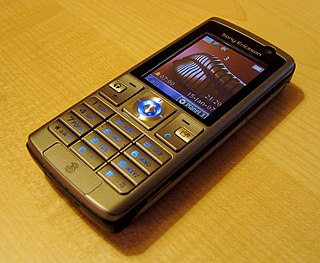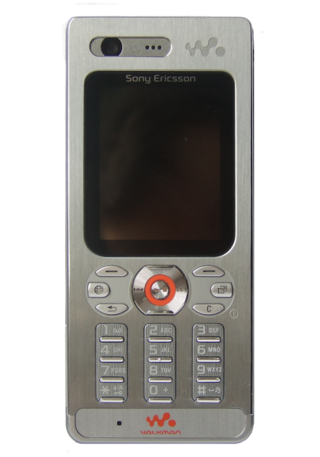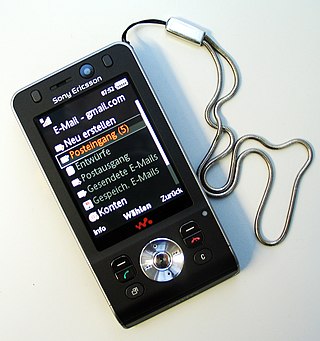
The Sony Ericsson K750, introduced in June 2005, is a high-end mobile phone, the successor to the now discontinued K700, and which was succeeded by the K800i in Q2 2006.

Cyber-shot is Sony's line of point-and-shoot digital cameras introduced in 1996. Cyber-shot model names use a DSC prefix, which is an initialism for "Digital Still Camera". Many Cyber-shot models feature Carl Zeiss trademarked lenses, while others use Sony, or Sony G lenses.

The Sony Ericsson K610i is a 3G phone that Sony Ericsson announced at the 3GSM World Congress on February 13, 2006. It was promoted as the smallest and lightest 3G phone available. It has been succeeded by the K530.

The Sony Ericsson K800i, and its variant, the Sony Ericsson K790, are mobile phone handsets manufactured by Sony Ericsson. Launched in July 2006, the phones are the successor to the Sony Ericsson K750i, and are the first to be tagged with the Cyber-shot branding. Both of the phones feature a 3.2-megapixel digital camera complete with a xenon flash, a protective lens cover, and a new "BestPic" bracketing feature. The new "BestPic" feature takes 9 full quality snapshots of a subject in quick succession, allowing the user to choose the best shots from them. On the entertainment front, the phones have a media player supporting MP3, AAC/AAC+/eAAC+ and WMA music files and 3GP/MPEG-4 video files. The phones also feature a RDS FM radio, and a Memory Stick Micro (M2) slot for expandable solid state memory. The K790/K800 models are also the first Sony Ericsson mobile phones to use ATI's Imageon 2192 graphics engine, which delivers a full 3D gaming graphics for Java and full support for its 3.2-megapixel camera. It is the phone used by James Bond in the 2006 Casino Royale film and trailers.

The Sony Ericsson W850i is the first 3G slider mobile phone by Sony Ericsson, introduced in Q2 2006. It is a member of their Walkman line, succeeding the Sony Ericsson W600. The phone made its first public appearance in the 2006 movie The Da Vinci Code, months before its release. It is similar mechanically to the Sony Ericsson K800i, but differs in form factor, use of the Memory Stick PRO Duo instead of the Memory Stick Micro, and camera quality.

The W810 is a camera phone produced by Sony Ericsson. It was released in January 2006. It is the successor of the W800.

The Sony Ericsson W880i is a mobile phone that was announced on 6 February 2007 and released in spring 2007. Part of Sony Ericsson's Walkman series, the phone has been popular due to its tiny dimensions and low weight. At only 9.4 mm thick, the W880 was one of the few phones on the market that were thinner than 1 cm (10 mm), the other notable example being the Nokia 5310 XpressMusic from later that year.

The Sony Ericsson W610i phone is based on the Sony Ericsson K550 and Sony Ericsson K610i. It is a quad-band GSM phone, but it does not offer 3G. The W610i has colour options similar to the Sony Ericsson W880i. This phone uses the TrackID and version 2.0 of the Walkman player.

The Sony Ericsson K810i is a dual-mode UMTS phone with a 3.2 Megapixel camera with autofocus and 16x digital zoom. It has the full range of mobile entertainment and business features including video telephony, Memory Stick Micro removable storage, picture blogging, full HTML browser, RSS feed support, and music and video players. It is a later iteration of the Sony Ericsson K800i, and both phones have since been succeeded by the Sony Ericsson K850i.

The Sony Ericsson W200 Walkman is a cellphone measuring 101 × 44 × 18mm and weighs 85g (3 oz). It features a VGA camera, an FM radio, and Sony's Walkman software, although it lacks Bluetooth.

The Sony Ericsson K850i is a high-end mobile phone when released in October 2007. It was announced in June 2007 as the flagship product in Sony Ericsson's K ("Kamera") series, with a 5 megapixel CMOS camera sensor. The K850 was the first Sony Ericsson phone released outside of NTT DoCoMo to support microSD and microSDHC along with Sony's traditional M2. It also introduces the usage of three touch-sensitive softkeys right under the display and a new form of navigation button, omitting the classic joystick introduced with the Ericsson T68. The camera interface has been revamped to resemble the format of cybershot digital cameras. According to the manufacturer the UMTS talk time has been significantly increased to 3 hours 30 min over its predecessor, the K800 and K810.. It was Sony Ericsson's first 3.5G HSDPA supporting mobile phone, and was also the first 3G "global" mobile with supporting all major operating network frequency in the world including GSM 850, GSM 900, GSM 1800, GSM 1900, HSDPA, UMTS 850, UMTS 1900, UMTS 2100.

The Sony Ericsson W910i is a slider model music phone. The W910i was announced on June 14, 2007, as a branded "Walkman phone" and uses version 3 of the 'Walkman Player'. The phone also features the shake control feature found on the W580 that enables music track switching by shaking the phone and also for Java ME based video games and applications using the JP-8.

The Sony Ericsson C905 is a high-end mobile phone in Sony's 'C' (Cyber-shot) range, which, along with the low-end 'S' (Snapshot) range cameras, supplants the earlier 'K' range of camera phones. It is the flagship model in Sony Ericsson's range for 2008 and it was released on 22 October 2008. It's the first 8-megapixel camera phone to be released outside Korea, while adding the Assisted GPS (A-GPS) and Wi-Fi function. It is also the first Sony Ericsson mobile phone to support the DLNA sharing network as well as the first Cyber-shot phone to also be released for AT&T.

Sony Ericsson Aino is a touch screen based slider mobile phone. It has a multimedia PlayStation 3-inspired touch menu, a large 3-inch (76 mm) touchscreen, VGA@30 FPS video recording. The 3-inch (76 mm) screen is touch-enabled but only in the multimedia part of the menu and the camera interface. Some third party applications like Opera-Mini also support the touch screen interface. It also has an 8.1-megapixel camera. The Aino uses NetFront 3.5 web browser for internet connectivity.

The C510 is one of the mobile phones in Sony Ericsson's Cyber-shot series. Released on 7 January 2009, it was a successor to the K510i model. It is widely characterised as one of Sony Ericsson best non-smartphone devices released to the market.

Sony Ericsson Xperia arc is an Android smartphone introduced by Sony Ericsson. It was released on March 24, 2011, in Japan and on April 1, 2011, in Europe. The smartphone has a curved "arc" appearance, hence the name.

The Sony Ericsson Xperia pro is an Android smartphone from Sony Ericsson which was launched in October 2011. The Xperia Pro has a 3.7-inch (94 mm) capacitive touch-screen, slider keyboard, smart phone with mobile BRAVIA engine which optimises the picture and runs at a resolution of 854×480 pixels, a 1 GHz Snapdragon processor, an 8.1 mega-pixel camera, a dedicated Two-step camera key, USB host port, HDMI-out, 512 MB of onboard RAM, and an 8 GB microSD card. The Sony Ericsson Xperia Pro is available in black, silver, or red.

The Sony Ericsson Xperia ray (ST18i) is an Android smartphone from Sony Ericsson. It was unveiled on 22 June 2011 in Singapore during CommunicAsia 2011. It was announced that the Xperia ray would be released globally in select countries from Q3 2011.

Sony Xperia T is an Android smartphone manufactured by Sony Mobile. Introduced on 29 August 2012, it is Sony Mobile's last device ever introduced to feature the Sony Ericsson liquid energy logo after Sony acquired Ericsson's stake in Sony Ericsson in January 2012. It was released in October 2012.

The Sony Ericsson Cedar (j108i), also known as Sony Ericsson Cedar GreenHeart, is a mobile phone from SE's J series of phones produced by Sony Ericsson released in September 2010. It is the last Sony Ericsson phone that run on proprietary Sony Ericsson A2 Operating System as Greenheart switched to the Sony Xperia line of Android Smartphones. The phone is one of Sony Ericsson's environmentally friendly "Greenheart" range, featuring devices made of recycled materials, longer battery life and low-energy chargers, as well as minimal use of paper through reduced packaging and the replacement of the traditional printed user manual with one stored on the phone. This device also the first cell phone from Sony Ericsson to fully abandon Sony's Proprietary Charger and Memory Card Format, The Memory Stick Pro Duo used in older models and Memory Stick Micro (M2) used in more newer feature models by using standard Micro USB for Charging and Data Transfer and Micro SD Format for expandability, adding the standard 3.5mm headphone jack on the top.





















